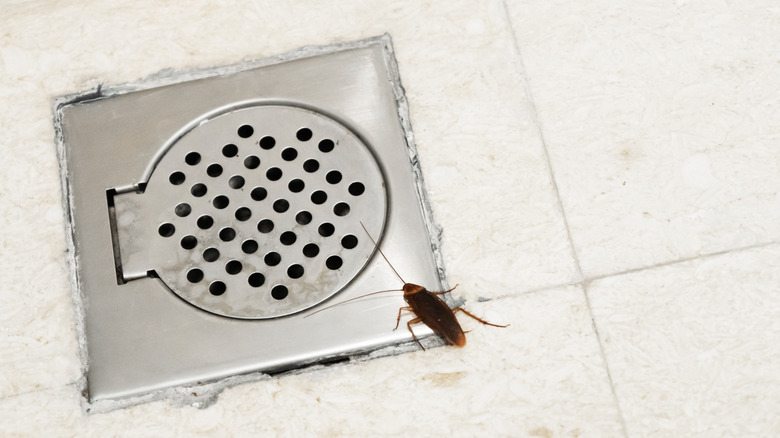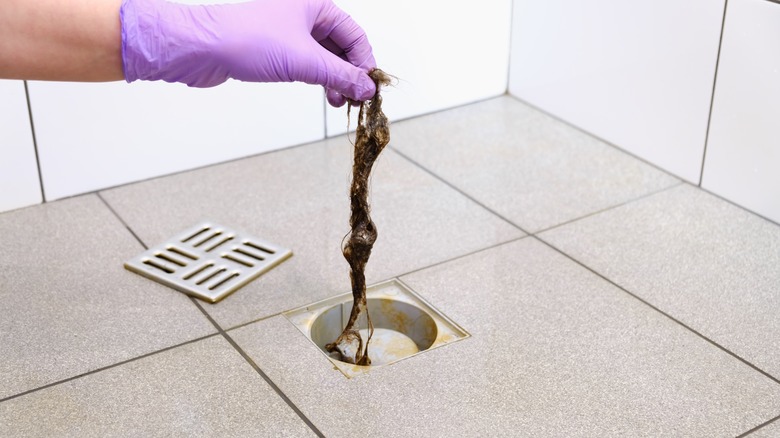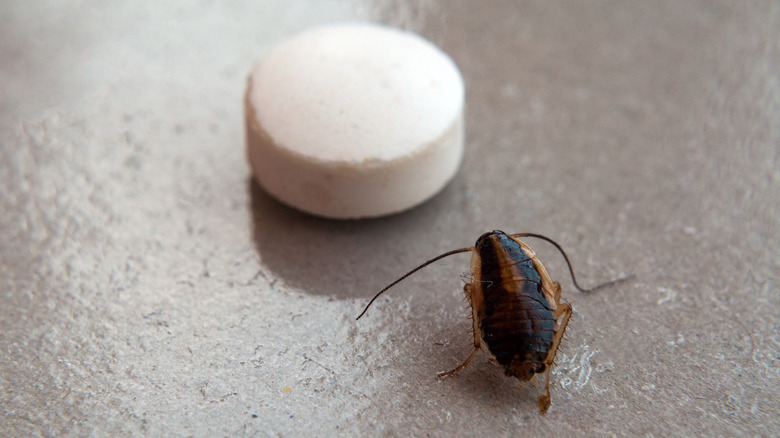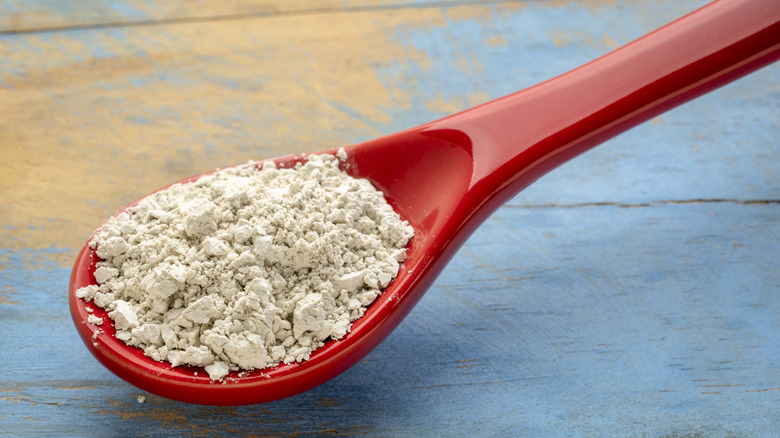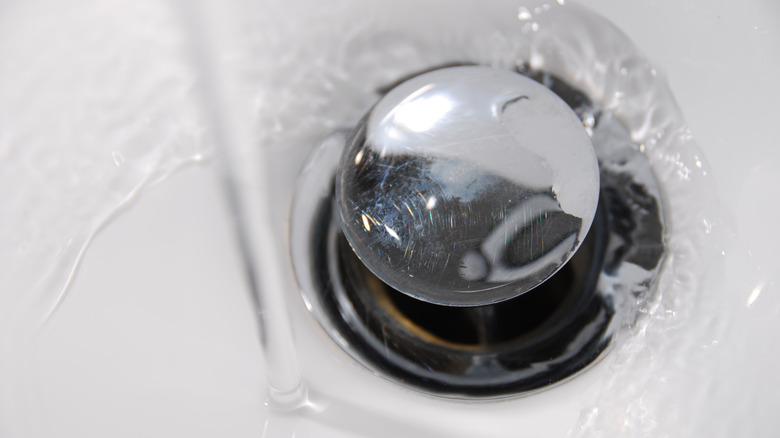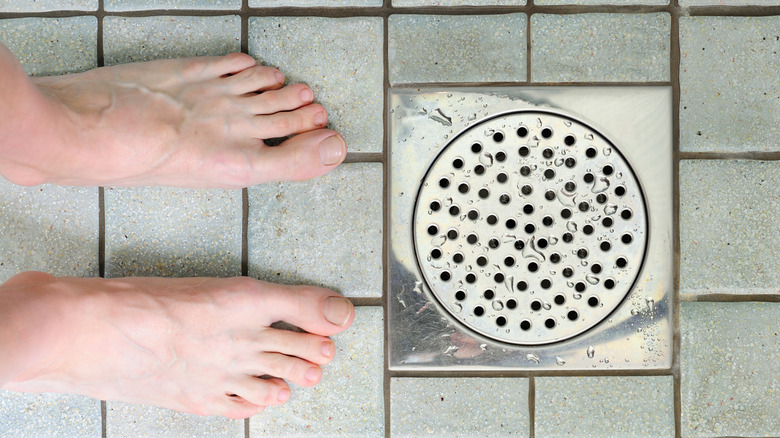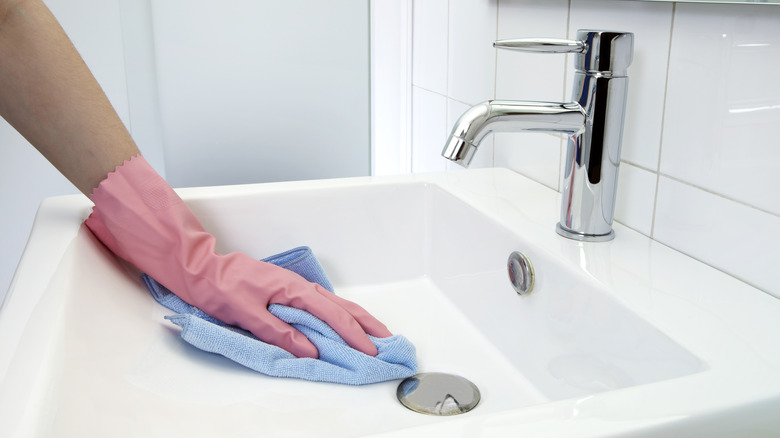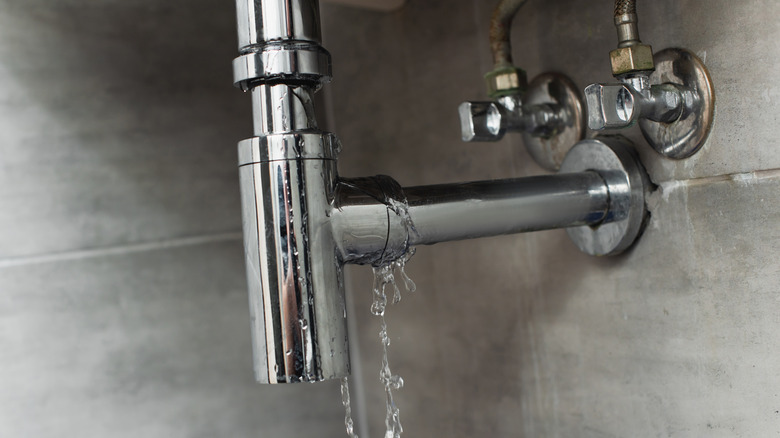The 7 Best Ways To Keep Bugs Out Of Your Drains
You might have recently discovered bugs living in your drains. This unsettling reality becomes even more pronounced when you realize that these insects, often tiny and unseen, can breed within your pipes, according to Terminix Pest Control. The slimy build-up in your pipes becomes a perfect breeding ground for them, leading to potential pest infestations that are more than just a mere annoyance. Understanding why and how these bugs make their way into your drains is key to keeping them out.
Often, they are attracted to the moisture and the organic matter that our daily activities wash down the sink. For instance, fruit flies are particularly drawn to fermenting residues from food, which often accumulate in kitchen sink drains. Once these insects find a hospitable environment in the moist, nutrient-rich confines of a drain, they quickly settle in and multiply. In this context, effective pest control is not just about reactionary measures; it's about proactive prevention. You'll have to combine various methods, including regular cleaning, physical barriers, and moisture control. From simple DIY solutions to installing physical barriers, the strategies are diverse but unified in their objective — they help reduce the likelihood of a bug infestation in your drains by dealing with the existing problem and creating conditions that are inherently unappealing to these pests.
Unclog your drains
The cornerstone of keeping bugs out of your drains is maintaining clear and unobstructed pathways. By physically removing blockages, you ensure your pipes are clear of the build-ups that attract pests. According to the Premier Draining Group, when drains become clogged, they create an environment ripe for insects by harboring stagnant water, making your drains an inadvertent haven for these pests. Here's a nifty trick that's as effective as it is simple: regularly flush your drains with a pot of hot water. But why stop there? Take things up a notch by mixing and pouring half a cup of baking soda and one cup of vinegar down the drain. Another effective approach to clean your drains is to use a plumber's snake or a drain auger. With its flexible coil, the snake can move through the bends and turns of your plumbing to dislodge and remove hair, soap scum, and other obstructions that hot water might not be able to flush out completely.
So why do these methods work so well? Well, it's like hitting the refresh button for your pipes since all the methods complement each other. Hot water and the natural cleaning mixture tackle the surface and the upper layers of the drain. They melt away greasy substances and dislodge small particles that might accumulate in your pipe, where debris tends to accumulate. The plumber's snake, on the other hand, goes deeper into the pipe, addressing the root of the problem.
Set baits and glue traps around the drain entry point
Stepping up the defense against drain bugs involves more than just regular cleaning. Enter the world of baits and glue traps — a proactive approach to catching these pests before they become a bigger problem. Let's break down how you can make these traps your allies in this battle. The first step is choosing the right spots to place them; typically, these are the areas around your drains where you've noticed bug activity. Baits are designed to attract bugs, drawing them in with the promise of a meal. Once they venture towards the bait, the glue traps work their magic, trapping them on contact. It's a simple yet effective one-two punch against these pests.
Now, why does this approach work so well? By targeting the bugs right at their point of entry, you're addressing the problem at its source. It's a proactive method that intercepts the bugs before they even have a chance to enter your drains and multiply. Check and replace these traps frequently to not only capture the bugs but also gain a clear understanding of their numbers and activity. This insight is invaluable, allowing you to adapt and refine your pest control strategy. The bait method also complements your regular cleaning and adds an extra layer of defense against drain bugs. And the best part? It's a low-effort approach with potentially great results.
Apply diatomaceous earth to cracks near the drain
In your quest to keep drain bugs at bay, don't overlook the power of diatomaceous earth. This natural, powdery substance is more than just dirt; it's a collection of fossilized remains of tiny aquatic organisms with a unique knack for tackling pesky insects. Applying it is a breeze. Focus on those sneaky nooks and crannies around your drains — the usual entry points for bugs. Sprinkling a bit of this earth in these spots creates an invisible yet deadly barrier for any insect that dares to cross it. It's like laying out an unwelcome mat for bugs.
You might wonder, "Can something so simple really work?" Absolutely. Its microscopic, jagged edges are lethal to bugs. These sharp particles work like tiny knives, cutting through the protective outer layers of insects, leading to dehydration and, ultimately, their demise. Furthermore, diatomaceous earth doesn't lose its mojo quickly. As long as it stays dry, it remains an active bug deterrent, providing long-term protection against those creepy crawlies trying to invade your drains. And guess what? It achieves this feat while being a more environmentally friendly option than insecticides. However, be sure to use food-grade diatomaceous earth due to its high purity and safety. It contains minimal crystalline silica, making it non-toxic and safe for use around humans and pets.
Install a sink drain plug
To keep your sink (whether in your bathroom or kitchen) drain bug-free, let's not forget the role of the drain plug. These are typically simple, solid pieces that fit snugly into the drain hole, keeping it fully covered. They come in various designs and materials. For example, the flip-it stopper operates with a simple action: flip it to one side to close the drain, and flip it back to open it. Its design is sleek and efficient, creating a secure barrier that's easy to manage. Next up is the bathtub or shower toe-touch stopper, which seals the drain securely with the lightest touch of your toe, locking or releasing with minimal effort. The ease of operation means it's more likely to be kept closed when the tub isn't in use, effectively keeping bugs at bay. Finally, consider the lift-and-turn stopper. To either open or close the drain, this type requires a slight lift and a turn. Its main draw is the control it provides over the drainage process, and its snug fit is superb for preventing any unwelcome insect visitors from entering.
A drain plug is essential because it's your first line of defense against bugs. Choosing the best one will depend on the sink or tub you're using it in, as well as your particular needs. Be sure you have the right measurements and design that fits seamlessly with your sink.
Install a drain cover or filter
Diving deeper into the world of drain maintenance, let's focus on drain covers, also sometimes described as drain filters. The point drain cover is perhaps the most traditional style. Typically found in the center of the shower floor, it is designed to handle water from all directions, funneling it down to a single point. Then, there's the linear drain cover — an elongated option particularly effective in handling large volumes of water. Lastly, hidden drain covers offer a more seamless look and are designed to blend in with the surrounding floor or sink material, making them almost invisible.
Drain covers and filters are especially important in the context of walk-in showers. Remember, these aren't to be confused with drain plugs, which are all about stopping water and keeping drains entirely closed. Drain covers allow water to flow while also playing a crucial role in filtering hair. As mentioned earlier, hair can clog your drains, ultimately causing standing water, an environment that many insects like drain flies find appealing. What sets drain covers apart is their design. They often sit on the shower floor, blending in seamlessly with the design, preventing trip hazards. The key with drain covers is ensuring they fit your drain size and type perfectly. You don't want any gaps that could let tiny insects sneak through. Additionally, opting for a cover with fine mesh is a smart move. This design detail stops bugs in their tracks, preventing them from turning your drain into their home.
Clean and seal off the outside of your drains
You might not realize it, but the space outside your drains (including the sink and the entire room) can also be a hotspot for attracting unwanted critters. So, the focus shouldn't only be on the inside of the drains. Try to create an outside environment that's unattractive to them. When tackling this task, pay special attention to areas where water tends to pool. These spots are like oases for pests, especially mosquitoes, who are always on the lookout for damp areas to lay their eggs. Also, ensure the sink area is free from toothpaste which is likely to attract ants. Additionally, incorporating natural bug repellents like peppermint oil or citrus peels near drains can further discourage bugs. After cleaning, make sure to dry the area thoroughly. It's not enough to wipe away the grime; eliminating excess moisture is a crucial step in making your drains less appealing to bugs.
Thorough cleaning of the drain's outside area is important because bugs, especially cockroaches and flies, are attracted to food particles and organic matter that often accumulate around drain areas. Regularly wiping down surfaces and ensuring no food residue remains can significantly reduce the likelihood of these pests taking up residence in your home. Moreover, some bugs, like silverfish and centipedes, thrive in moist environments. By maintaining a dry and clean area around your drains, you disrupt the habitat these pests need to survive.
Reduce moisture around the drain area
Achieving a dryer environment involves a few simple yet effective strategies. First, make it a habit to regularly wipe down surfaces. After using the sink or shower, a quick wipe-down can remove excess water, reducing the overall moisture level. Next, keep an eye out for leaks. A constant drip can contribute to a humid environment in the home, so fix any leaks as soon as you spot them. It's not just about water waste; it's about removing another source of moisture that can attract pests. Proper ventilation plays a significant role as well. In areas like bathrooms and kitchens, good airflow helps reduce humidity levels. Using an exhaust fan or keeping a window open can greatly aid in ventilating the space and keeping it dry. Sometimes, the humidity level might be a bit more stubborn. This is where absorbent mats or dehumidifiers, come into play. Placing absorbent mats around areas prone to wetness, like under the sink or around the shower, can soak up excess moisture. In very humid environments, a dehumidifier can be a game-changer, actively pulling moisture from the air and maintaining a drier atmosphere.
These methods are vital because reducing moisture around your drains helps create an environment that's less inviting to pests, especially in areas like bathrooms and kitchens where dampness is a common issue. Moisture is like a welcome sign for bugs, so keeping the area dry is essential in deterring them.
